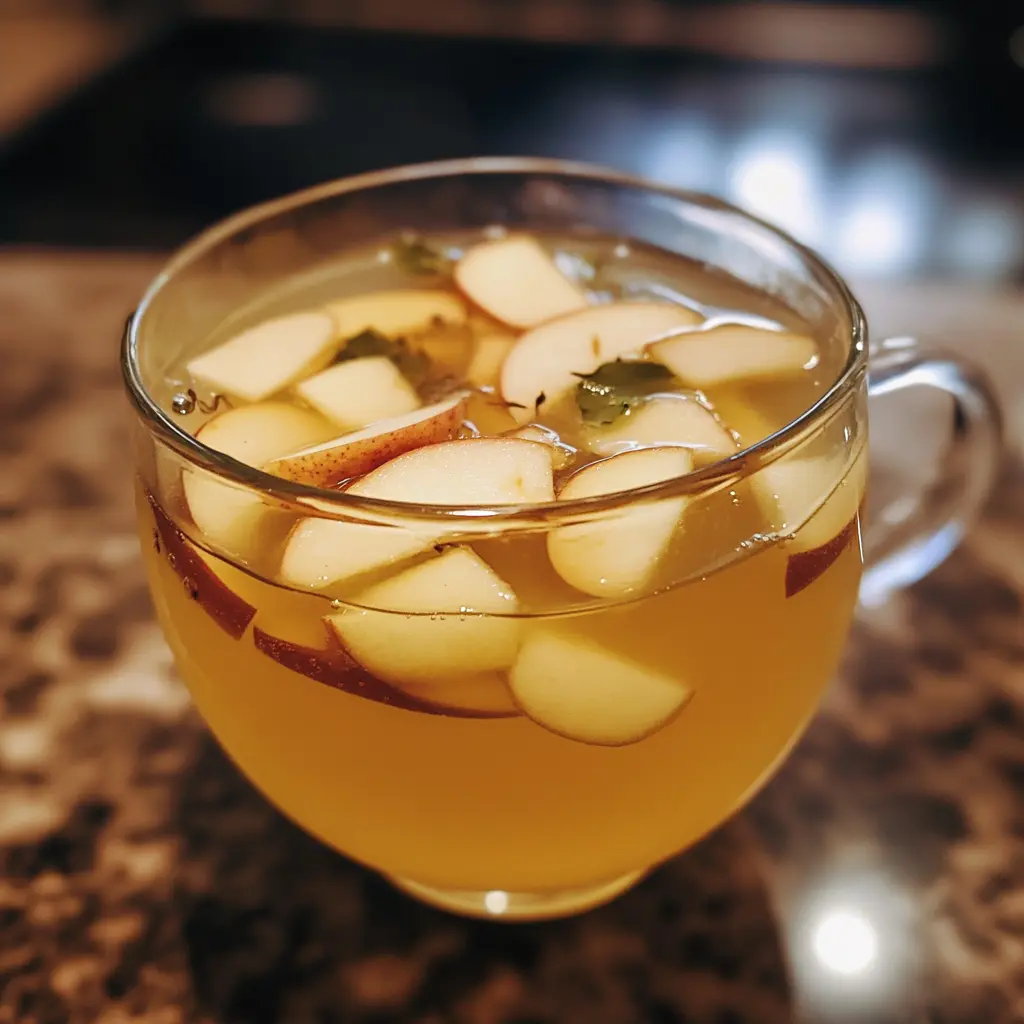Apple cider is the quintessential fall beverage, full of warmth, spice, and the essence of crisp apples. Whether you’re sipping it hot by a fire or enjoying it chilled, apple cider has a way of bringing comfort and coziness to any occasion. This drink has a long history, from being a colonial American staple to becoming a beloved seasonal treat at autumn festivals, gatherings, and holidays. The best part? It’s incredibly versatile and can be made right in your own kitchen!
In this article, we’ll take you through everything you need to know about making the perfect apple cider, including a breakdown of ingredients, step-by-step instructions, and tips for perfecting your recipe. Whether you’re a cider connoisseur or new to making it at home, this guide will provide you with everything you need to make a delicious batch of apple cider.
Introduction
Apple cider is more than just a fall favorite—it’s a time-honored tradition that spans centuries and cultures. While it can be served cold, apple cider is often enjoyed warm during chilly months, infused with spices like cinnamon, cloves, and nutmeg to bring out its natural sweetness and depth of flavor.

While store-bought apple cider is convenient, making it at home allows you to customize the flavor to your liking and enjoy the fresh taste of apples at their peak. With only a few simple ingredients, you can create a batch of homemade apple cider that tastes miles better than anything from the store. Plus, it’s a fun way to use up extra apples after a trip to the orchard!
Ingredients Breakdown
Key Ingredients:
- Apples: The star of the show! For the best flavor, use a mix of different apple varieties. Sweet apples like Fuji, Gala, and Honeycrisp balance the tartness of apples like Granny Smith or McIntosh. This mix creates a well-rounded flavor.
- Cinnamon Sticks: Cinnamon adds warmth and depth to the cider. Using whole cinnamon sticks is best for a slow infusion of flavor, but ground cinnamon can also be used if necessary.
- Cloves: Whole cloves provide a spicy, aromatic note to the cider. Be careful not to overdo it—just a few are enough to add depth.
- Allspice: This spice enhances the cider with its slightly peppery and warm flavor, complementing the sweetness of the apples.
- Nutmeg: A dash of nutmeg provides a warm, nutty flavor that blends beautifully with the apples and other spices.
- Water: Water is added to the apples to create the base for the cider, helping to extract the apple juice and spice flavors during the cooking process.
- Sweetener (optional): Depending on the sweetness of your apples, you might want to add sugar, brown sugar, honey, or maple syrup. Taste your cider first before deciding if it needs extra sweetness.
Optional Ingredients:
- Orange or Lemon: Citrus slices can add a refreshing brightness to the cider, balancing out the sweetness of the apples.
- Ginger: Fresh ginger root or ground ginger adds a spicy kick to your cider, giving it an extra layer of warmth.
- Star Anise: For a more complex flavor, add star anise. It provides a subtle licorice-like taste that pairs well with the sweetness of the apples.
- Vanilla Extract: Just a teaspoon of vanilla extract can add a creamy, comforting note to your cider.
- Alcohol (optional): For a spiked version of apple cider, you can add rum, bourbon, or apple brandy after the cider has simmered and cooled slightly.
Step-by-Step Recipe Instructions
Ingredients:
- 10-12 medium apples (a mix of sweet and tart varieties)
- 8 cups water
- 2-3 cinnamon sticks
- 1 tablespoon whole cloves
- 1 teaspoon allspice
- 1/2 teaspoon ground nutmeg
- 1/4 cup brown sugar or honey (optional, adjust to taste)
Instructions:
- Prepare the Apples: Wash the apples thoroughly, then cut them into quarters. There’s no need to peel or core the apples, as the entire fruit will be used to extract the flavor.
- Cook the Apples: Place the apples in a large stockpot or slow cooker and add enough water to cover them, usually about 8 cups. Add the cinnamon sticks, cloves, allspice, and nutmeg to the pot.
- Simmer the Cider: Bring the mixture to a boil over high heat. Once boiling, reduce the heat to low and let it simmer uncovered for about 2 hours, or until the apples are soft and have broken down.
- Mash the Apples: After simmering, use a potato masher or large spoon to mash the apples in the pot, helping release more of their juice and flavor. Let the mixture continue to simmer for another 30-60 minutes.
- Strain the Cider: Carefully pour the apple mixture through a fine mesh strainer or cheesecloth into a large bowl or pitcher. Discard the apple solids and spices.
- Sweeten to Taste: If desired, add sugar, honey, or maple syrup to sweeten the cider. Stir until fully dissolved, and adjust the sweetness to your liking.
- Serve Warm or Cold: Serve the cider warm with a cinnamon stick for garnish, or refrigerate and serve chilled over ice. If you’re feeling festive, add a slice of orange or a splash of alcohol for an extra kick!
Tips for Perfecting Your Apple Cider
- Use a Variety of Apples: Using different types of apples creates a well-rounded flavor. Mixing sweet and tart varieties ensures that your cider isn’t too sweet or too sour.
- Don’t Skip the Spices: Whole spices are best for mulling, as they release flavor slowly without turning the cider gritty. For stronger flavors, increase the simmering time, but be careful not to overpower the apples.
- Adjust Sweetness Gradually: Depending on the type of apples you use, your cider might be naturally sweet. Always taste before adding any sugar or sweetener to avoid over-sweetening.
- Avoid Boiling: Keeping the heat at a low simmer is important. Boiling can cause the apples to lose their fresh flavor and break down the spices too quickly, resulting in a bitter taste.
- Strain Thoroughly: For a smooth cider, strain the mixture carefully, using a cheesecloth or fine strainer to catch any pulp or leftover spices.
Variations and Customizations
- Spiked Apple Cider: For an adult version, add a splash of bourbon, rum, or brandy to your cider. Be sure to add it just before serving to keep the alcohol from evaporating during cooking.
- Cider with Chai Spices: For a twist, try adding chai spices like cardamom, fennel seeds, and a black tea bag during simmering. This gives your cider a spiced, exotic flavor.
- Caramel Apple Cider: Add a drizzle of caramel sauce to your warm cider for a dessert-like drink. Top with whipped cream and a sprinkle of cinnamon for an extra treat.
- Cranberry Apple Cider: Add fresh cranberries during the simmering process for a tart, fruity variation. The cranberries will add a pop of color and a unique flavor to the cider.
- Sparkling Apple Cider: For a refreshing twist, let the cider cool, then mix it with sparkling water or club soda before serving. Garnish with fresh fruit for a sparkling version of the classic drink.
Serving Suggestions
- Warm and Cozy: Serve warm apple cider in large mugs with a cinnamon stick for stirring. This is a perfect option for cold fall evenings or holiday gatherings.
- Chilled and Refreshing: If you prefer your cider cold, chill it in the fridge and serve over ice with a slice of lemon or orange. This is a great option for autumn picnics or daytime get-togethers.
- Pair with Desserts: Apple cider pairs well with a variety of fall desserts. Serve alongside apple pie, gingerbread, or cinnamon-spiced cookies to enhance the warm flavors.
- Serve with Savory Dishes: Apple cider isn’t just for desserts! It pairs beautifully with savory fall dishes like roasted pork, chicken, or butternut squash soup.
Storing and Reheating Leftovers
Apple cider can be stored and enjoyed for several days after making it, and reheating is simple.
- Storing: Once cooled, transfer any leftover cider to an airtight container and store it in the refrigerator for up to 5 days. If you made a large batch, you can also freeze it in portions for up to 3 months.
- Reheating: To reheat, pour the cider into a saucepan and warm it gently over low heat. Avoid boiling the cider to preserve its flavor. If reheating from frozen, allow it to thaw in the refrigerator overnight before warming it up.
Health Benefits of Apple Cider
Apple cider isn’t just delicious; it also has some potential health benefits:
- Rich in Antioxidants: Apples are high in antioxidants, which help fight free radicals in the body and promote overall health.
- Vitamin C: Fresh apples and citrus added to apple cider provide a boost of vitamin C, essential for immune support, especially during cold and flu season.
- Supports Digestion: The spices in apple cider, like cinnamon and cloves, are known to support healthy digestion and may help soothe an upset stomach.
- Hydration: Apple cider is a naturally hydrating beverage, perfect for keeping you warm while also quenching your thirst.
Frequently Asked Questions (Q&A)
Q1: Can I use apple juice instead of fresh apples to make cider?
Yes, you can use apple juice as a shortcut, but it won’t have the same depth of flavor as fresh apples. If you use juice, reduce the amount of sugar, as store-bought apple juice is often sweetened.
Q2: How can I make my apple cider less sweet?
If your cider turns out too sweet, you can balance it by adding more water or a squeeze of lemon juice. Using tart apples in your next batch will also reduce sweetness.
Q3: Can I make apple cider in a slow cooker?
Yes! Slow cookers are perfect for making apple cider. Add all the ingredients to the slow cooker, set it to low, and let it cook for 6-8 hours, stirring occasionally.
Q4: How do I know when my apple cider is ready?
Your cider is ready when the apples are soft and have broken down, and the spices have infused the liquid. The longer it simmers, the richer the flavor will be.
Q5: Can I reuse the apple solids after making cider?
Yes! The leftover apple solids can be used to make applesauce or added to baked goods like muffins and quick breads.
Conclusion
Apple cider is a timeless and versatile drink that can be enjoyed in many forms, whether it’s warm and comforting during the fall or chilled and refreshing year-round. With just a few simple ingredients and a little time, you can create a batch of homemade cider that’s bursting with flavor.
From classic recipes to creative variations, apple cider offers something for everyone. Whether you’re sharing it with friends at a holiday gathering or enjoying a quiet evening at home, this delicious drink is sure to warm your soul and bring a touch of autumn to every sip. Try making your own cider today and savor the sweet, spiced flavors of the season!

